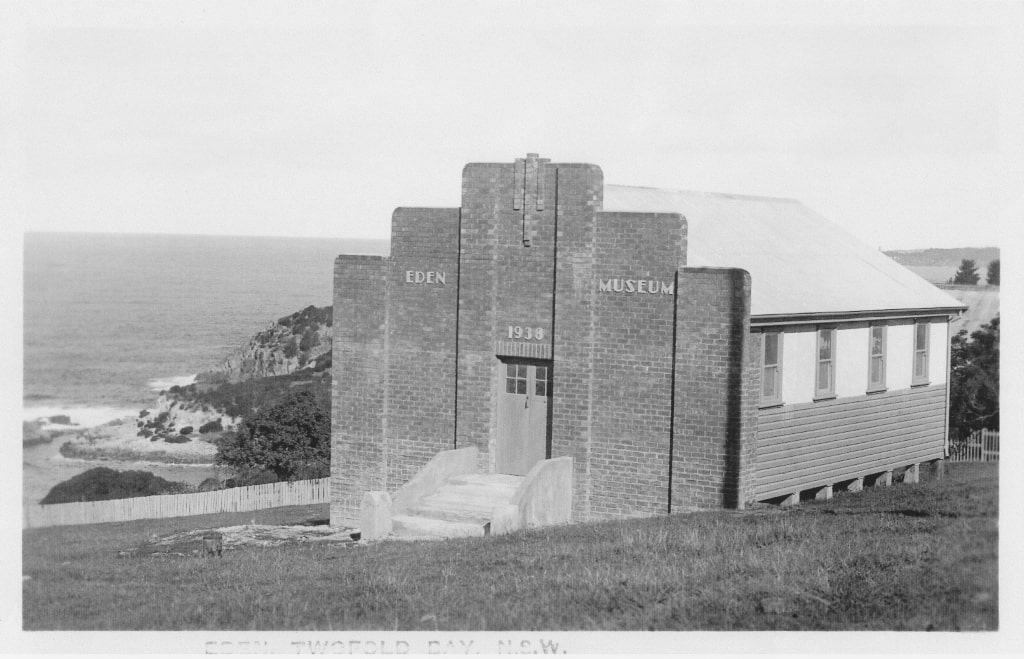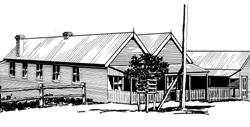Historic Sites
In 1993, the sesquicentennial year of Eden’s foundation was celebrated through the activities and projects organised by the Eden Killer Whale Museum. One of the projects was to erect information plaques on places of historical interest in Eden. Below is a list of those sites as well as links to their pages detailing the specific history of each location.

Bank of New South Wales
This building was erected in 1903 by T. J. Ramsay and leased to the Bank of NSW. Rent in 1905 was £96 per annum. A Government Savings Bank branch had been available at the ‘Half House’ since 1874.

Begaville
The original Begaville was the residence of Solomon Solomon, J.P.

Mary MacKillop Hall and St. Josephs Convent
The first Catholic Church was erected here in 1860. Additions in the form of a Presbytery and school were destroyed by fire in 1877. After the death of her mother Flora McKillop, when the Ly-ee-moon was shipwrecked at Green Cape in 1886, Mother Mary McKillop (now Saint Mary) established a school on this site utilising part of the church in 1891. Mother Mary visited the school on two occasions to witness the progress of the school in 1899 and 1901.

Cock’s Blacksmiths
During the late 19th century, Young & Plumb coach builders and Blacksmith Forge occupied this site.

Court House
Eden’s first Court of Petty Sessions was established in Eden in 1847. The present building which is still in use as a Local Court was built in 1858 under the Colonial Architect Alexander Dawson. Early Magistrates included Sir Oswald Brierly and William and James Walker.

Crown and Anchor
Eden’s oldest surviving building and first hotel – now used as a residence and B&B An elegant regency building with local stone foundations, shingles (now covered by an iron roof), oyster shell mortar rendering, Australian red cedar doors and plaster ceilings from lime, termite nest and cow hair binding. It was completed in 1845 and its first licensee James Rixon was granted its liquor licence in the same year – just before the Seahorse Inn was granted a licence at Boydtown.

Customs House
As described by local author H. P. Wellings, the Customs House “was built of locally made brick with expensive cedar work. Commanding an uninterrupted view of the harbour, it had six rooms, an imposing entrance hall and large grounds.

Diversi’s Store
Diversi produce mart catered for those teamsters plying between the tableland and Eden port.

Eden’s First Land Sale
The township of Eden was surveyed in 1842 and the first blocks auctioned on 9 March 1843.

Eden Killer Whale Museum
Under Construction

“Eden Observer” Office
The “Eden Observer and South Coast Advocate” was published from 1903 to 1910 and the building was home to several other local newspapers and printers.

Exchange & Commercial Hotels

Great Southern Inn
This building was erected in 1847 as a general store and post office for George Barclay. In 1851 John Hopkins took out a liquor licence for the Great Southern Hotel. After 1935 its name was changed to Hotel Eden and more recently to The Great Southern Inn. Over the years the balconies and guest accommodation has been added.

The Half House
This two storey Georgian style building of local stone and Welsh slate was semi-completed by James Rixon of Cathcart in approximately 1850. When not completed, it became known as the ‘Half House’. It has been in turn Eden’s first telegraph office and the residence of the Telegraph Station Master Charles Kebby. It was restored in the 1990’s and is presently a private residence.

Hopkins’ House

Hotel Australasia
Sabina Pike had the hotel built in 1909 but licencing laws prevented her from becoming the licencee. The hotel was advertised as ‘The Sanatorium of the South Coast’ and had its own wells and extensive vegetable gardens.

Howards’ Store
This store and residence was built for Matt Howard circa 1904. Matt sold benzene, oils, motor vehicle accessories, new tyres and was agent for motor cars. Ownership of this building has changed many times and it is now part of the Heritage House Motel and Units.

Imlay Brothers Whaling Station
Alexander, Peter and George Imlay established a shore-based whaling station in 1833.

Imlay Shire Council Chambers
Eden’s first Local Government Chambers were located here after the Local Government Shire Act was passed in 1905. After the Electoral Rolls were collected and completed, the first election was held in 1906 and the first meeting of the elected Imlay Shire Council was held in December 1906. The Chambers are now used for the Eden Access Centre.

“Magnet” Office
Newspapers were printed on this site from the mid 1800’s and included the “Eden Free Press”, “Twofold Bay & Maneroo Observer”, “Eden Propeller” and “Eden Observer”.

Nicholsons

Pier Hotel
Under Construction

Police Watch House
Under Construction

Post Office
First occupied in 1891 as the new Post Office with a telephone exchange added in 1909. The Post Office was transferred to its existing location in Imlay Street in 1971. The original Post Office was established at Boydtown in 1844 and transferred to the present site of the Great Southern Hotel in 1847. It was later established further down Imlay Street at the old Crown and Anchor hotel.

Public School
Originally known as the Eden National School, the original classroom building was erected and opened in 1857 with an enrolment of 12 girls and 30 boys. The original building is the third oldest classroom still in use, for its original purpose, in NSW and the oldest outside Sydney. Unfortunately the original building is located in the centre of the school precinct and impossible to see from either street frontage. The Morton Bay Fig tree on the south west corner was originally planted in Imlay Street in 1906.

Ramsey’s Store
The store was outstanding in design for the times and advertised as a newsagents, draper, ironmonger and general store, and also sold fashionable millinery, fancy goods, boots and Ramsey’s blend of tea.

St Georges Uniting Church
St Georges Uniting Church is one of the oldest continuously used churches in NSW. Originally a Presbyterian Church, it was opened by Rev. John Dunmore Lang in 1866. The grounds now host a community garden and a farmers market is held there once a month.

The Log Cabin
Erected in 1936 as a Girl Guides Hall with funding from J.R. Logan (then owner of Edrom Lodge on Twofold Bay) and to a Canadian design. Logs are local Stringybark and the slit shingles are Ash. The stones are from the Yowaka River. It has since been used as a town library and community activity centre.

Thomas Raine’s Whaling Station
Thomas Raine established the first shore whaling station on the Australian mainland at Twofold Bay in 1818.

Tom Tracey’s Garage
Originally Dowling’s “Bedrock Store” which was later converted to a service station.

Twofold Bay Development League Offices
The Twofold Bay Development League building in Imlay Street was the first home of Old Tom’s skeleton. John Logan angered by the neglect and determined boycott of the South Coast was instrumental, with a number of others, in forming the Twofold Bay Development League around 1922. He was elected President and retained that position until his death. The organization published the Southern Eastern Gate in 1926 to promote everything the district had to offer. Copies were sent to people in influential positions around the country.

Wabressa
Wabressa guest house formerly on this site, was run by William Nicholas Stone. His wife Maisie, three daughters, Sylvia, Merri and Enid, and five sisters.

Warren’s House & Shed
Bob Warren, fisherman, and his family lived in the cottage as did his son Robbie and this small adjoining building was used as extra accommodation for a young family.

Whiters’ Garage
The building originally on this site was constructed by Whiter Brothers and occupied by Wal Whiter’s expert motor repairs when Wal and his family came to Eden in 1939.
